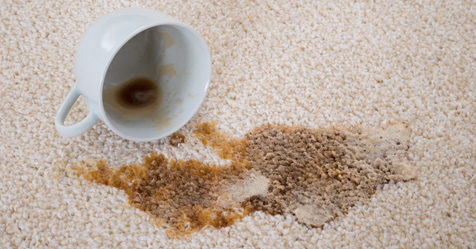Anyone who has ever encountered a red stain knows how hard it is to remove.
As a professional carpet cleaner once said, “It is the red stain that has given many a carpet cleaner second thoughts as to his profession of choice.”
Both synthetic and natural red stains can be problematic. Of course, the best way to lessen red stain problems is by making sure spills are attended to as quickly as possible. When that doesn’t happen, cleaning can become a real challenge.
Your first step (after identifying carpet fiber type, of course) in cleaning a red stain is to figure out whether the stain is natural, synthetic, or manmade. Red wine will need to be attacked differently than Kool-Aid ®, for example. Once you’ve decided which type of red stain you’re dealing with, you can tailor your cleaning approach.
Synthetic Red Stains
Among the various stains in this category, red Kool-Aid is often the first to spring to mind. It is an especially difficult stain because of all the dyes. Liquid cough medicines, colored juices, lipstick, and many other items can fall into this category as well.
To clean a synthetic red stain, you’ll generally have to employ a reducing agent product that contains a common ingredient like sodium metabisulfite. Be sure to mix your reducer per manufacturer specification and then apply it to the stained area, leaving it for the appropriate dwell time. Reducing agents work faster if you use a damp towel and steam—a wallpaper steamer or iron will do the trick. Take precautions as to not remove the carpet’s original color along with the stain.
The reducer will remove most of the red stain. Any stain debris left will be more easily removed with rinsing. However, always have realistic expectations when it comes to stains. If a stain has been in the carpet fibers for a long time, or has had other chemicals previously applied to it in a failed cleaning attempt, removal will be much more difficult.
Natural Stains
Red wine is a problematic organic red stain. Other common natural red stains come from tomato-based spills (pasta sauce, ketchup, etc.) and natural juices like cherry and others.
To clean organic red stains, use an oxidizing agent product like hydrogen peroxide. Again, it’s important to follow the manufacturer specifications when mixing your oxidizing agent.
The removal process is the same as for synthetic stains. Apply the oxidizing agent to the stain, followed by a damp towel and steam. Be sure not to use excessively high heat. As with the reducing agent, an oxidizer can remove carpet color along with the red stain if a cleaner isn’t careful.
Removing red stains can be tough — really tough. But with care and attention, a cleaner can feel the satisfaction that comes with beating this stain nemesis.




